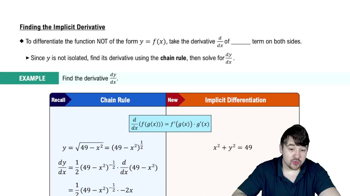Table of contents
- 0. Functions7h 52m
- Introduction to Functions16m
- Piecewise Functions10m
- Properties of Functions9m
- Common Functions1h 8m
- Transformations5m
- Combining Functions27m
- Exponent rules32m
- Exponential Functions28m
- Logarithmic Functions24m
- Properties of Logarithms34m
- Exponential & Logarithmic Equations35m
- Introduction to Trigonometric Functions38m
- Graphs of Trigonometric Functions44m
- Trigonometric Identities47m
- Inverse Trigonometric Functions48m
- 1. Limits and Continuity2h 2m
- 2. Intro to Derivatives1h 33m
- 3. Techniques of Differentiation3h 18m
- 4. Applications of Derivatives2h 38m
- 5. Graphical Applications of Derivatives6h 2m
- 6. Derivatives of Inverse, Exponential, & Logarithmic Functions2h 37m
- 7. Antiderivatives & Indefinite Integrals1h 26m
- 8. Definite Integrals4h 44m
- 9. Graphical Applications of Integrals2h 27m
- 10. Physics Applications of Integrals 2h 22m
4. Applications of Derivatives
Implicit Differentiation
Problem 69b
Textbook Question
The following equations implicitly define one or more functions.
b. Solve the given equation for y to identify the implicitly defined functions y=f₁(x), y = f₂(x), ….
x+y³−xy=1 (Hint: Rewrite as y³−1=xy−x and then factor both sides.)
 Verified step by step guidance
Verified step by step guidance1
Start by rewriting the given equation x + y³ - xy = 1 as y³ - 1 = xy - x. This sets up the equation for factoring.
Notice that the left side y³ - 1 is a difference of cubes, which can be factored using the formula a³ - b³ = (a - b)(a² + ab + b²). Here, a = y and b = 1.
Apply the difference of cubes formula to factor the left side: y³ - 1 = (y - 1)(y² + y + 1).
On the right side, factor out the common factor x from xy - x to get x(y - 1).
Set the factored forms equal: (y - 1)(y² + y + 1) = x(y - 1). To solve for y, consider the cases where y - 1 = 0 and where y - 1 ≠ 0, leading to different solutions for y.
 Verified video answer for a similar problem:
Verified video answer for a similar problem:This video solution was recommended by our tutors as helpful for the problem above
Video duration:
6mPlay a video:
Was this helpful?
Key Concepts
Here are the essential concepts you must grasp in order to answer the question correctly.
Implicit Functions
Implicit functions are defined by equations where the dependent variable is not isolated on one side. In this case, the equation x + y³ - xy = 1 defines y as a function of x without explicitly solving for y. Understanding how to manipulate these equations is crucial for identifying the relationships between variables.
Recommended video:

Finding The Implicit Derivative
Factoring
Factoring is the process of breaking down an expression into simpler components, or factors, that when multiplied together yield the original expression. In the context of the given equation, factoring helps to simplify the equation after rewriting it, making it easier to isolate y and identify the functions defined by the equation.
Recommended video:

Limits of Rational Functions: Denominator = 0
Solving for y
Solving for y involves rearranging an equation to express y explicitly in terms of x. This is essential for identifying the functions y = f₁(x), y = f₂(x), etc. In the given problem, after rewriting and factoring the equation, one can isolate y to find the specific forms of the functions defined implicitly by the original equation.
Recommended video:

Solving Logarithmic Equations

 5:14m
5:14mWatch next
Master Finding The Implicit Derivative with a bite sized video explanation from Nick
Start learningRelated Videos
Related Practice


